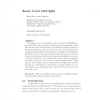Free Online Productivity Tools
i2Speak
i2Symbol
i2OCR
iTex2Img
iWeb2Print
iWeb2Shot
i2Type
iPdf2Split
iPdf2Merge
i2Bopomofo
i2Arabic
i2Style
i2Image
i2PDF
iLatex2Rtf
Sci2ools
CORR
2007
Springer
2007
Springer
Exact Cover with light
We suggest a new, unconventional, way for solving the YES/NO version of the Exact Cover problem by using the massive parallelism of light. The idea is to build a device which can generate all possible solutions of the problem and then to pick the correct one. In our case the device has a graph-like representation and the light is traversing it by following the routes given by the connections between nodes. The nodes are connected by arcs in a special way which lets us to generate all possible covers (exact or not) of the given set. For selecting the correct solution we assign to each item, from the set to be covered, a special integer number. These numbers will actually represent delays induced to light when it passes through arcs. The solution is represented as a subray arriving at a certain moment in the destination node. This will tell us if an exact cover does exist or not. Keywords Optical computing, Unconventional computing, Natural computing, NP-complete problems, Exact Cover.
CORR 2007 | Education | Exact Cover | Exact Cover Problem | Solution |
| Added | 13 Dec 2010 |
| Updated | 13 Dec 2010 |
| Type | Journal |
| Year | 2007 |
| Where | CORR |
| Authors | Mihai Oltean, Oana Muntean |
Comments (0)

